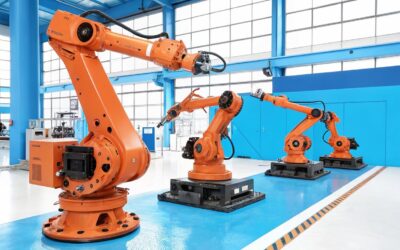Plural ➝ EOATs
Also known as End Effector
- EOAT refers to the specialized tools or attachments that are installed at the end of a robotic arm or manipulator.
These tools are designed to interact with objects or perform specific tasks in various industrial applications. - EOAT enables robots to perform tasks such as gripping, handling, manipulating, or assembling objects with precision and efficiency.
Etymology
The term “EOAT” is an acronym derived from “End-of-Arm Tooling.”
It originated within the field of robotics, specifically in the context of industrial automation and robotic arms.
The use of robotic arms with specialized tooling at their ends has become increasingly prevalent in manufacturing and assembly processes.
Synonyms
End-effectors, Robot grippers, Robotic tooling
Pronunciation
ee-oh-ay-tee, not ee-oat
Related Terms and Derivatives
Robotic arm – Gripper – Tool changer – Manipulator
Three Quotations and Historical References
“EOATs revolutionized the manufacturing industry by enabling robots to perform a wide range of tasks with speed, precision, and consistency”
John Smith, Robotics Industry Expert
“The development of advanced EOATs has significantly increased the versatility and adaptability of industrial robots, allowing them to handle complex assembly processes”
Jane Thompson, Research Scientist
“EOATs have played a crucial role in automating repetitive tasks, improving efficiency, and ensuring worker safety in factories worldwide”
Robotics Today, Vol. 5, Issue 2, 2020
Fields of Application
EOATs find applications in various industries, including:
- Automotive manufacturing: EOATs are used for tasks such as part handling, welding, painting, and assembly.
- Electronics industry: EOATs are utilized in pick-and-place operations, PCB assembly, and quality control.
- Packaging and logistics: EOATs enable robots to handle and pack products, palletize, and perform sorting tasks.
- Pharmaceuticals: EOATs are employed in drug dispensing, labeling, and packaging processes.
- Food industry: EOATs are used for food handling, sorting, packaging, and inspection tasks.
Example Sentences
“The robotic arm was equipped with a specialized EOAT designed for precise component placement.”
“The company upgraded its assembly line by integrating versatile EOATs, reducing production time by 30%.”
“The gripper EOAT enabled the robot to pick and place fragile objects with utmost care.”
Curiosities
- EOATs can vary widely in design and functionality, depending on the specific application requirements. They can include various types of grippers, suction cups, magnetic attachments, or even specialized tools for cutting, welding, or painting.
- EOATs often incorporate sensors and feedback systems to enhance their capabilities, allowing for precise control and adaptability in handling objects.
- The development of collaborative robots (cobots) has led to the emergence of EOATs designed for safe human-robot interaction, featuring soft and compliant materials.
Analogies
Think of EOAT as the “hand” of a robotic arm, allowing it to interact with objects, much like how a human hand enables us to manipulate things.
EOAT is comparable to the diverse range of tools found in a toolbox. Just as different tools are used for specific tasks, EOATs are customized for different applications in robotics.
Five Frequently Asked Questions
What are the main types of EOATs?
The main types of EOATs include grippers, suction cups, magnetic attachments, welding tools, cutting tools, and specialized end-effectors for specific tasks.
Can EOATs be easily interchanged on robotic arms?
Yes, many robotic systems incorporate tool changers, which enable quick and seamless interchangeability of EOATs, allowing robots to perform different tasks without significant downtime.
How are EOATs controlled?
EOATs are typically controlled through the robotic arm’s programming, which sends signals to actuate the specific motions or operations of the tooling. Sensors in the EOAT provide feedback to the control system.
Are EOATs only used in industrial settings?
EOATs are predominantly used in industrial applications, but they can also be employed in other domains such as healthcare, research, and even home automation, depending on the specific requirements.
Can EOATs be customized for specific objects or tasks?
Yes, EOATs can be designed and customized to meet specific requirements, such as handling delicate objects, adapting to different shapes and sizes, or performing specialized operations like painting or quality control.



